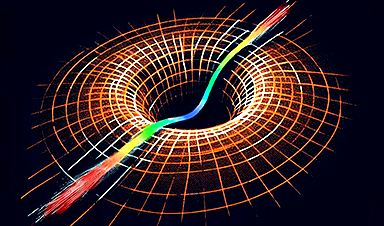Researchers have derived a new wave equation, linking wave mechanics with the general theory of relativity and the arrow of time, offering solutions to long-standing physics debates and introducing applications for novel materials.
Researchers at Tampere University and the University of Eastern Finland have reached a milestone in a study where they derived a new kind of wave equation, which applies to accelerating waves. The novel formalism has turned out to be an unexpectedly fertile ground for examining wave mechanics, with direct connections between accelerating waves, the general theory of relativity, as well as the arrow of time.
Light Interaction With Matter
Whenever light interacts with matter, light appears to slow down. This is not a new observation and standard wave mechanics can describe most of these daily phenomena.
However, at the boundary, the incident light must experience an acceleration. So far, this has not been accounted for.
“Basically, I found a very neat way to derive the standard wave equation in 1+1 dimensions. The only assumption I needed was that the speed of the wave is constant. Then I thought to myself: what if it’s not always constant? This turned out to be a really good question,” says Assistant Professor Matias Koivurova from the University of Eastern Finland.
By assuming that the speed of a wave can vary with time, the researchers were able to write down what they call an accelerating wave equation. While writing down the equation was simple, solving it was another matter.
“The solution didn’t seem to make any sense. Then it dawned on me that it behaves in ways that are reminiscent of relativistic effects,” Koivurova recounts.
Working together with the Theoretical Optics and Photonics group, led by Associate Professor Marco Ornigotti from Tampere University, the researchers finally made progress. To obtain solutions that behave as expected, they needed a constant reference speed – the vacuum speed of light. According to Koivurova, everything started to make sense after realizing that. What followed was an investigation of the surprisingly far-reaching consequences of formalism.
No Hope for a Time Machine?
In a breakthrough result, the researchers showed that in terms of accelerating waves, there is a well-defined direction of time; a so-called ‘arrow of time.’ This is because the accelerating wave equation only allows solutions where time flows forward, but never backward.
“Usually, the direction of time comes from thermodynamics, where an increasing entropy shows which way time is moving,” Koivurova says.
However, if the flow of time were to reverse, then entropy would start to decrease until the system reached its lowest entropy state. Then entropy would be free to increase again.
This is the difference between ‘macroscopic’ and ‘microscopic’ arrows of time: while entropy defines the direction of time for large systems unambiguously, nothing fixes the direction of time for single particles.
“Yet, we expect single particles to behave as if they have a fixed direction of time!” Koivurova says.
Since the accelerating wave equation can be derived from geometrical considerations, it is general, accounting for all wave behavior in the world. This in turn means that the fixed direction of time is also a rather general property of nature.
Relativity Triumphs Over the Controversy
Another property of the framework is that it can be used to analytically model waves that are continuous everywhere, even across interfaces. This in turn has some important implications for the conservation of energy and momentum.
“There is this very famous debate in physics, which is called the Abraham–Minkowski controversy. The controversy is that when light enters a medium, what happens to its momentum? Minkowski said that the momentum increases, while Abraham insisted that it decreases,” Ornigotti explains.
Notably, there is experimental evidence supporting both sides.
“What we have shown, is that from the point of view of the wave, nothing happens to its momentum. In other words, the momentum of the wave is conserved,” Koivurova continues.
What allows the conservation of momentum are relativistic effects. “We found that we can ascribe a ‘proper time’ to the wave, which is entirely analogous to the proper time in the general theory of relativity,” Ornigotti says.
Since the wave experiences a time that is different from the laboratory time, the researchers found that accelerating waves also experience time dilation and length contraction. Koivurova notes that it is precisely the length contraction that makes it seem like the momentum of the wave is not conserved inside a material medium.
Exotic Applications
The new approach is equivalent to the standard formulation in most problems, but it has an important extension: time-varying materials. Inside time-varying media light will experience sudden and uniform changes in the material properties. The waves inside such materials are not solutions to the standard wave equation.
This is where the accelerating wave equation comes into the picture. It allows the researchers to analytically model situations that were only numerically accessible before.
Such situations include an exotic hypothetical material called disordered photonic time crystal. Recent theoretical investigations have shown that a wave propagating inside the said material will slow down exponentially, while also increasing exponentially in energy.
“Our formalism shows that the observed change in the energy of the pulse is due to a curved space-time the pulse experiences. In such cases, energy conservation is locally violated,” Ornigotti says.
The research has wide-reaching implications, from everyday optical effects to laboratory tests of the general theory of relativity, while giving an idea of why time has a preferred direction.
Reference: “Time-varying media, relativity, and the arrow of time” by Matias Koivurova, Charles W. Robson and Marco Ornigotti, 19 October 2023, Optica.
DOI: 10.1364/OPTICA.494630
News
Miller School Researchers Pioneer Nanovanilloid-Based Brain Cooling for Traumatic Injury
A multidisciplinary team at the University of Miami Miller School of Medicine has developed a breakthrough nanodrug platform that may prove beneficial for rapid, targeted therapeutic hypothermia after traumatic brain injury (TBI). Their work, published in ACS [...]
COVID-19 still claims more than 100,000 US lives each year
Centers for Disease Control and Prevention researchers report national estimates of 43.6 million COVID-19-associated illnesses and 101,300 deaths in the US during October 2022 to September 2023, plus 33.0 million illnesses and 100,800 deaths [...]
Nanomedicine in 2026: Experts Predict the Year Ahead
Progress in nanomedicine is almost as fast as the science is small. Over the last year, we've seen an abundance of headlines covering medical R&D at the nanoscale: polymer-coated nanoparticles targeting ovarian cancer, Albumin recruiting nanoparticles for [...]
Lipid nanoparticles could unlock access for millions of autoimmune patients
Capstan Therapeutics scientists demonstrate that lipid nanoparticles can engineer CAR T cells within the body without laboratory cell manufacturing and ex vivo expansion. The method using targeted lipid nanoparticles (tLNPs) is designed to deliver [...]
The Brain’s Strange Way of Computing Could Explain Consciousness
Consciousness may emerge not from code, but from the way living brains physically compute. Discussions about consciousness often stall between two deeply rooted viewpoints. One is computational functionalism, which holds that cognition can be [...]
First breathing ‘lung-on-chip’ developed using genetically identical cells
Researchers at the Francis Crick Institute and AlveoliX have developed the first human lung-on-chip model using stem cells taken from only one person. These chips simulate breathing motions and lung disease in an individual, [...]
Cell Membranes May Act Like Tiny Power Generators
Living cells may generate electricity through the natural motion of their membranes. These fast electrical signals could play a role in how cells communicate and sense their surroundings. Scientists have proposed a new theoretical [...]
This Viral RNA Structure Could Lead to a Universal Antiviral Drug
Researchers identify a shared RNA-protein interaction that could lead to broad-spectrum antiviral treatments for enteroviruses. A new study from the University of Maryland, Baltimore County (UMBC), published in Nature Communications, explains how enteroviruses begin reproducing [...]
New study suggests a way to rejuvenate the immune system
Stimulating the liver to produce some of the signals of the thymus can reverse age-related declines in T-cell populations and enhance response to vaccination. As people age, their immune system function declines. T cell [...]
Nerve Damage Can Disrupt Immunity Across the Entire Body
A single nerve injury can quietly reshape the immune system across the entire body. Preclinical research from McGill University suggests that nerve injuries may lead to long-lasting changes in the immune system, and these [...]
Fake Science Is Growing Faster Than Legitimate Research, New Study Warns
New research reveals organized networks linking paper mills, intermediaries, and compromised academic journals Organized scientific fraud is becoming increasingly common, ranging from fabricated research to the buying and selling of authorship and citations, according [...]
Scientists Unlock a New Way to Hear the Brain’s Hidden Language
Scientists can finally hear the brain’s quietest messages—unlocking the hidden code behind how neurons think, decide, and remember. Scientists have created a new protein that can capture the incoming chemical signals received by brain [...]
Does being infected or vaccinated first influence COVID-19 immunity?
A new study analyzing the immune response to COVID-19 in a Catalan cohort of health workers sheds light on an important question: does it matter whether a person was first infected or first vaccinated? [...]
We May Never Know if AI Is Conscious, Says Cambridge Philosopher
As claims about conscious AI grow louder, a Cambridge philosopher argues that we lack the evidence to know whether machines can truly be conscious, let alone morally significant. A philosopher at the University of [...]
AI Helped Scientists Stop a Virus With One Tiny Change
Using AI, researchers identified one tiny molecular interaction that viruses need to infect cells. Disrupting it stopped the virus before infection could begin. Washington State University scientists have uncovered a method to interfere with a key [...]
Deadly Hospital Fungus May Finally Have a Weakness
A deadly, drug-resistant hospital fungus may finally have a weakness—and scientists think they’ve found it. Researchers have identified a genetic process that could open the door to new treatments for a dangerous fungal infection [...]





















